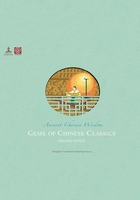
三字经 (sān zì jīng)
Three Character Classic
Making characters as easy as 1-2-3
“Three Character Classic” was one of the most popular texts for elementary education in China for more than 700 years until the middle of last century. Almost all children at school used to be required to recite the text of 1,248 Chinese characters in three-character verses for easy memorization.
Many historians have attributed this text to Wang Yinglin (1223-1296), a famous scholar of the Southern Song Dynasty (1127-1279). But they say that the version we see today was revised by later scholars because it contains content about history after the Southern Song Dynasty.
As a writer and scholar of Chinese classics and history, Wang obtained the title of “Presented Scholar,” a graduate of the Imperial Palace examination, at the age of 18. Three years later, he was appointed as an official of today’s Quzhou City in his home province of Zhejiang in eastern China. The highest office Wang ever held was the Director of the Board of Rites in the Imperial Court.
It was said that Wang authored “Three Character Classic” in order to spread Confucian classics and knowledge of Chinese history among children. Therefore, he wrote the text both short and simple and arranged it all into three-character verses, very suitable for reading and reciting.
As a result, even today, more than 60 years after it stopped being used as a text for primary schools, many people in China can still recite some of its most readable verses.
“Three Character Classic” is divided into six parts, each focusing on a specific topic. The text begins with four verses about the core belief of Confucianism:
“People at birth,
All innately kind.
Natures are alike,
But habits different.”
Then, it goes on to preach traditional values, such as to follow filial piety, to observe the proprieties, to respect teachers and to be diligent and to study hard.

It even mentions an ancient episode concerning Kong Rong (153-208 AD), a Han Dynasty writer and descendant of Confucius. As a boy of 10, Kong was asked to share two pears with his younger brother. Kong immediately gave the bigger one to his brother while keeping the smaller one for himself.
The story has been told for centuries in the country to encourage young students to take after Kong’s humbleness and generosity.
In addition to teaching children the basics of math, Chinese language, music and science, the text also lists titles of important Chinese classics in Confucianism and works of other ancient philosophers.
The text tells students that before one begins to study Chinese history, he or she must first become versed in those classic master works.
After expounding all kinds of knowledge and principles, the classic text tells students in conclusion that people studying and working hard will be eventually rewarded, while those who waste their time on play will regret of it one day.
Because of its rich content, beautiful verses and simple style, it was translated into Mongolian and Manchu languages during the Yuan and Qing dynasties. In the early years of Meiji Reign (1868-1912), it was widely used as a text in private schools in Japan. Later, it was also translated into English, French and Italian.
Now, it has been listed by UNESCO as one of its recommended children’s readings worldwide.
Later, people also tried to imitate the writing style of “Three Character Classic” to spread knowledge of specific subjects and religions. So, for many hundreds of years, a good number of books have been published in China in the “three-character” style.
Titles include: “Three Character Classic for Females,” “Three Character Classic of Geology,” “Three Character Classic of Medicine,” “Three Character Classic of Military,” “Three Character Classic of Buddhism” and “Three Character Classic of Taoism.”